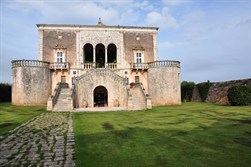Rural residences and hunting lodges
 In these residences where the aristocrats stopped for fairly short periods, there were factors, administrators and procurators, who permanently resided inside the vast landholdings of the lord, from which they went to check their economic performance, production and the work in the fields. Sometimes, when these homes were in areas with forests, the noble owner stopped more frequently, to also engage in what became one of the biggest pastimes of the European aristocracy, hunting, always practiced by kings and nobles from all over Europe, but that from the mid-sixteenth century, underwent a real boom. Between the sixteenth and seventeenth centuries, in fact, the lives of European aristocrats allotted greater space and greater dignity to recreation and leisure time, which had precise intervals throughout the year along with places for it and hunting increasingly asserted itself as a privileged recreational activity.
In these residences where the aristocrats stopped for fairly short periods, there were factors, administrators and procurators, who permanently resided inside the vast landholdings of the lord, from which they went to check their economic performance, production and the work in the fields. Sometimes, when these homes were in areas with forests, the noble owner stopped more frequently, to also engage in what became one of the biggest pastimes of the European aristocracy, hunting, always practiced by kings and nobles from all over Europe, but that from the mid-sixteenth century, underwent a real boom. Between the sixteenth and seventeenth centuries, in fact, the lives of European aristocrats allotted greater space and greater dignity to recreation and leisure time, which had precise intervals throughout the year along with places for it and hunting increasingly asserted itself as a privileged recreational activity.
Those who owned fiefs with forests rich in game set up ad hoc dwellings, called cascine di caccia (hunting lodges). Those who did not reside in fiefdoms with suitable areas procured new ones. The hunting lodge, far from being a simple shelter and place to pause during fatigue of hunting, as they were until the sixteenth century, became representative buildings, embellished or built according to Baroque style and responded to specific functions: stables and dwellings for hunting dogs, spaces in which horses were bred that ended up accounting for, in some cases, significant economic activity. But the house had to have large rooms to accommodate the distinguished guests of the landowner who participated in the hunts, halls for evening parties, chapels for worship and also paintings, frescoes, sculptures that recalled hunting activities, with references to the classic gods of hunting, along with mythological episodes or passages on the subject. These buildings found their ultimate expression in the Kingdom of Naples, during the eighteenth century, thanks to the known passion of King Charles III and his son Ferdinand IVThe son of Charles III of Bourbon (1716-1788) and Maria Amalia of Saxony (1724-1760), Ferdinand (1751-1825) was King of Sicily from 1759 to 1816 as Ferdinand III and King of Naples from 1759 to 1799, with the name of Ferdinand IV. After the brief interlude of the Neapolitan Republic he returned to the throne of Naples in the same year (1799) until 1806. After the defeat of Napoleon Bonaparte and the decisions made at the Congress of Vienna, Ferdinand became the first ruler of the Kingdom of the Two Sicilies (as Ferdinand I) from 1816 to 1825. for hunting. The Bourbon kings acquired a number of estates where they built a large amount of hunting lodges called caccette, scattered throughout the territory of the Kingdom of Naples and Sicily, buildings of significant architectural merit, at times of imposing dimensions.
